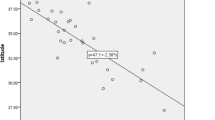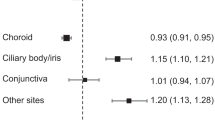Abstract
Background
Studies finding an inverse correlation of ambient solar irradiance with cancer mortality were the first to suggest that sun exposure and probably, therefore, vitamin D might protect against some cancers. Such correlation has been shown in Asian populations in some studies. We analyzed the correlation between mortality and incidence from a number of cancers and ambient solar ultraviolet (UV) B irradiance in China.
Methods
Cancer mortality data were obtained from the Second National Death Survey conducted in a sample of 263 counties in China from 1990 to 1992. National cancer registration data 1998–2002 in China were used for estimation of cancer incidence. Satellite measurements of cloud-adjusted ambient UVB intensity at 305 nm were obtained from a NASA database and GIS methods used to estimate the average daily irradiance for the 263 counties in 1990. We estimated cancer mortality rate ratios per 10 mW/(nm m2) change in UVB by fitting a negative binomial regression model with mortality as the response variable and UVB as the independent variable, adjusted for sex, age, and urban or rural area.
Results
Mortality rates for all cancers and cancers of the esophagus, stomach, colon and rectum, liver, lung, breast, and bladder were inversely correlated with ambient UVB. This correlation was present in men and women and rural residents for all these cancers but not urban residents for cancers of the esophagus, colon and rectum and liver. Lung cancer mortality showed the strongest inverse correlation with an estimated 12% fall per 10 mW/(nm m2) increase in UVB irradiance even if adjusted for smoking. Only incidence rates for cancers of the esophagus, stomach, colon and rectum and cervix were inversely correlated with ambient UVB. Mortality and incidence from nasopharyngeal cancer increased with increasing UVB [respectively 27 and 12% per mW/(nm m2)]. Mortality from cancer of the cervix also increased, but to a lesser extent and mortality from leukemia was not consistently correlated with UVB irradiance.
Conclusion
Mortality from all cancers together and most major cancers in China was inversely associated with solar UVB. These associations were similar to those observed in a number of populations of European origin. Incidence of some cancer types had the same correlation with UVB. They suggest the possibility that vitamin D may reduce the incidence or improve the outcome of cancer in Chinese people.




Similar content being viewed by others
References
Armstrong BK, Kricker A (2001) The epidemiology of UV induced skin cancer. J Photochem Photobiol B 63:8–18
Moon SJ, Fryer AA, Strange RC (2005) Ultraviolet radiation: effects on risks of prostate cancer and other internal cancers. Mutat Res 571(1–2):207–219
Kricker A, Armstrong BK, Hughes AM, Goumas C et al. (2008) Interlymph Consortium. Personal sun exposure and risk of non-Hodgkin lymphoma: a pooled analysis from the Interlymph Consortium. Int J Cancer 122(1):144–154
Knight JA, Lesosky M, Barnett H, Raboud JM, Vieth R (2007) Vitamin D and reduced risk of breast cancer: a population-based case-control study. Cancer Epidemiol Biomarkers Prev 16(3):422–429
Garland CF, Garland FC (1980) Do sunlight and vitamin D reduce the likelihood of colon cancer? Int J Epidemiol 9:227–231
Rhee HV, Coebergh JW, Vries ED (2009) Sunlight, vitamin D and the prevention of cancer: a systematic review of epidemiological studies. Eur J Cancer Prev 18(6):458–475
Frampton RJ, Omond SA, Eisman JA (1983) Inhibition of human cancer cell growth by 1, 25-dihydroxyvitamin D3 metabolites. Cancer Res 43:4443–4447
Colston KW, Mackay AG, James SY et al (1992) EB1089: a new vitamin D analogue that inhibits the growth of breast cancer cells in vivo and in vitro. Biochem Pharmacol 44:2273–2280
Skowronski GJ, Peehl DM, Feldman D (1993) Vitamin D and prostate cancer: 1, 25-dihydroxyvitamin D3 receptors and actions in human prostate cancer cell lines. Endocrinology 132:1952–1960
Anzano MM, Smith JM, Uskokovic MR et al (1994) 1,25-Dihydroxy-16-ene-23-yne-26, 27-hexafluorocholecalciferol (Ro24–5531), a new deltanoid (vitamin D analogue) for prevention of breast cancer in the rat. Cancer Res 54:1653–1656
International Agency for Research on Cancer (2008) Vitamin D and Cancer, IARC working group reports, vol 5. WHO Press, World Health Organization, Geneva
Garland CF, Gorham ED, Mohr SB, Garland FC (2009) Vitamin D for cancer prevention: global perspective. Ann Epi 19(7):468
Kato I, Tajima K, Kuroishi T et al (1985) Latitude and pancreatic cancer. Jpn J Clin Oncol 15:403–413
Mazoue T (2006) Ecological study of solar radiation and cancer mortality in Japan. Health Phys 87:532–538
Kinoshita S, Wagatsuma Y, Okada M (2007) Geographical distribution for malignant neoplasm of the pancreas in relation to selected climatic factors in Japan. Int J Health Geogr. 6:34
Uehara M, Takahashi K, Hoshuyanma T, Pan G, Feng Y (2003) Geographical correlation between ambient UVB level and mortality risk of leukemia in Japan. Environmental Res 92:78–84
Archer VE (1989) Latitudinal variation of digestive tract cancers in the US and China. Nutr Cancer 12:213–223
Grant WB (2007) Does solar ultraviolet irradiation affect cancer mortality rates in China? Asian Pac J Cancer Prev 8:236–242
Office for Cancer Prevention, Control, Ministry of Health, P.R. China (2007) Malignant tumor mortality survey report (1990–1992), 1st edn. People’s Medical Publishing House, Beijing
Office for Cancer Prevention, Control, Ministry of Health, P.R. China (1980) Malignant tumor mortality survey report, 1st edn. People’s Medical Publishing House, Beijing
Armstrong B (1980) The epidemiology of cancer in the Peoples Republic of China. Int J Epidemiol 9:305–315
ftp://toms.gsfc.nasa.gov/pub/eptoms/data/uv_ery_4_wavelengths/uv305/; Accessed on 23 May 2008
Bernard JB (1997) Vitamin D and ultraviolet radiation: meeting lighting needs for captive animals (http://www.nagonline.net/Technical%20Papers/NAGFS00297VitD-JONIFEB24,2002MODIFiED.pdf; Accessed on 22 Apr 2008)
Lawless JF (1987) Negative binomial and mixed Poisson regression. Can J Stat-Revue Canadienne De Statistique 15:209–225
Doll R, Payne P, Waterhouse J (1966) Cancer incidence in five continents: a technical report. UICC, Berlin
Estève J, Benhamou E, Raymond L (1994) Statistical methods in cancer research. Descriptive epidemiology, vol IV. International Agency for Research on Cancer, Lyon
Davison AC, Hinkley DV (1997) Bootstrap methods and their application. Cambridge University Press, Cambridge
Liu BQ, Peto R, Chen ZM, Boreham J et al (1998) Emerging tobacco hazards in China: 1. Retrospective proportional mortality study of one million deaths. BMJ 317:1411–1422
Grant WB (2007) An ecologic study of cancer mortality rates in Spain with respect to indices of solar UV irradiance and smoking. Int J Cancer 120:1123–1127
Abnet CC, Chen W, Dawsey SM et al (2007) Serum 25(OH)-vitamin D concentration and risk of esophageal squamous dysplasia. Cancer Epidemiol Biomarkers Prev 16(9):1889–1893
Chen W, Dawsey SM, Qiao YL et al (2007) Prospective study of serum 25(OH)-vitamin D concentration and risk of oesophageal and gastric cancers. Br J Cancer 97(1):123–128
Guo X, Johnson RC, Deng H et al (2009) Evaluation of nonviral risk factors for nasopharyngeal carcinoma in a high-risk population of Southern China. Int J Cancer 124(12):2942–2947
Hrushesky WJ, Sothern RB, Rietveld WJ, Du-Quiton J, Boon ME (2006) Sun exposure, sexual behavior and uterine cervical human papilloma virus. Int J Biometeorol 50(3):167–173
Hrushesky WJ, Sothern RB, Rietveld WJ, Du Quiton J, Boon ME (2005) Season, sun, sex, and cervical cancer. Cancer Epidemiol Biomarkers Prev 14(8):1940–1947
Franceschi S, Herrero R, Clifford GM et al (2006) Variations in the age-specific curves of human papillomavirus prevalence in women worldwide. Int J Cancer 119:2677–2684
Chen T-C, Lee J-Y, Wang S-Y, Chang C-L, Yang Y-C (2005) Relevant factors for cervical cancer among young women in Taiwan. Taiwanese J Obstetrics Gynaecol 44:143–147
Boscoe FP, Schymura MJ (2006) Solar ultraviolet-B exposure and cancer incidence and mortality in the United States, 1993–2000. BMC Cancer 6:264
Mohr SB, Garland CF, Gorham ED et al (2008) Could ultraviolet B irradiance and vitamin D be associated with lower incidence rates of lung cancer? J Epidemiol Community Health 62:69–74
Giovannucci E, Liu Y, Rimm EB, Hollis BW, Fuchs CS, Stampfer MJ, Willett WC (2006) Prospective study of predictors of vitamin D status and cancer incidence and mortality in men. J Natl Cancer Inst 98:451–459
Grant WB (2006) The likely role of vitamin D from solar ultraviolet-B irradiance in increasing cancer survival. Anticancer Res 26(4A):2605–2614
Zhou W, Suk R, Liu G, Park S, Neuberg DS, Wain JC, Lynch TJ, Giovannucci E, Christiani DC (2005) Vitamin D is associated with improved survival in early-stage non-small cell lung cancer patients. Cancer Epidemiol Biomarkers Prev 14:2303–2309
Zhou W, Heist RS, Liu G et al (2007) Circulating 25-hydroxyvitamin d levels predict survival in early-stage non-small-cell lung cancer patients. J Clin Oncol 25:479–485
Guan QR, Ying C, Ma XC (1984) National survey on prevalence of rickets in infants and young children. In: Guan QR (ed) Prevention and treatment of rickets (1). Hei Long Jiang Publishing Bureau, Harbin, pp 25–26
Zhou H (1991) Rickets in China. In: Glorieux FH (ed) Rickets. Raven Press, New York, pp 253–261
Strand MA, Perry J, Zhao J, Fischer PR, Yang J, Li S (2009) Severe vitamin D-deficiency and the health of North China children. Matern Child Health J 13(1):144–150
Foo LH, Zhang Q, Zhu K et al (2009) Low vitamin D status has an adverse influence on bone mass, bone turnover, and muscle strength in Chinese adolescent girls. J Nutr 139(5):1002–1007
Woo J, Lam CW, Leung J et al (2008) Very high rates of vitamin D insufficiency in women of child-bearing age living in Beijing and Hong Kong. Br J Nutr 99(6):1330–1334
Wat WZ, Leung JY, Tam S, Kung AW (2007) Prevalence and impact of vitamin D insufficiency in southern Chinese adults. Ann Nutr Metab 51(1):59–64
Du X, Greenfield H, Fraser DR, Ge K, Trube A, Wang Y (2001) Vitamin D deficiency and associated factors in adolescent girls in Beijing. Am J Clin Nutr 74:494–500
Acknowledgments
Wanqing’s study is supported by Chinese National 8th 5 years Programs for Science and Technology Development No. 85-914-01-07. Mark Clements was supported by Australian National Health and Medical Research Council Capacity Building Grant in Population Health Research No. 262121 and Career Development Award No. 471491, both of which are funded by the Australian National Health and Medical Research Council. Bruce Armstrong’s research is supported by a University of Sydney Medical Foundation Program Grant.
Author information
Authors and Affiliations
Corresponding author
Appendix
Appendix
The association between UVB irradiance and lung cancer mortality is potentially confounded by smoking. Assuming that there is no effect modification between UVB and smoking on lung cancer mortality, we can model the lung cancer mortality rateLC by RRUVB [p smoking RRsmoking + (1−p smoking)] ≅ RRUVB p smoking RRsmoking, where RRUVB is the rate ratio for UVB exposure, p smoking is the prevalence of smoking and RRsmoking is the rate ratio for smoking. If we model the UVB rate ratio by exp(a + b × UVB) and smoking prevalence by exp(c + d × UVB) for constants b and d and intercepts a and c, then rateLC = RRsmoking exp(a + c+(b + d)UVB). We can then estimate an adjusted UVB rate ratio using exp(b + d)/exp(d), which requires modeling the change in smoking prevalence by UVB.
Rights and permissions
About this article
Cite this article
Chen, W., Clements, M., Rahman, B. et al. Relationship between cancer mortality/incidence and ambient ultraviolet B irradiance in China. Cancer Causes Control 21, 1701–1709 (2010). https://doi.org/10.1007/s10552-010-9599-1
Received:
Accepted:
Published:
Issue Date:
DOI: https://doi.org/10.1007/s10552-010-9599-1




